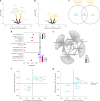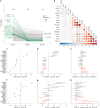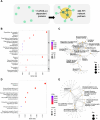Serum proteomics reveal APOE-ε4-dependent and APOE-ε4-independent protein signatures in Alzheimer's disease
- PMID: 39169269
- PMCID: PMC11485263
- DOI: 10.1038/s43587-024-00693-1
Serum proteomics reveal APOE-ε4-dependent and APOE-ε4-independent protein signatures in Alzheimer's disease
Erratum in
-
Author Correction: Serum proteomics reveal APOE-ε4-dependent and APOE-ε4-independent protein signatures in Alzheimer's disease.Nat Aging. 2024 Oct;4(10):1509. doi: 10.1038/s43587-024-00718-9. Nat Aging. 2024. PMID: 39285016 Free PMC article. No abstract available.
Abstract
A deeper understanding of the molecular processes underlying late-onset Alzheimer's disease (LOAD) could aid in biomarker and drug target discovery. Using high-throughput serum proteomics in the prospective population-based Age, Gene/Environment Susceptibility-Reykjavik Study (AGES) cohort of 5,127 older Icelandic adults (mean age, 76.6 ± 5.6 years), we identified 303 proteins associated with incident LOAD over a median follow-up of 12.8 years. Over 40% of these proteins were associated with LOAD independently of APOE-ε4 carrier status, were implicated in neuronal processes and overlapped with LOAD protein signatures in brain and cerebrospinal fluid. We identified 17 proteins whose associations with LOAD were strongly dependent on APOE-ε4 carrier status, with mostly consistent associations in cerebrospinal fluid. Remarkably, four of these proteins (TBCA, ARL2, S100A13 and IRF6) were downregulated by APOE-ε4 yet upregulated due to LOAD, a finding replicated in external cohorts and possibly reflecting a response to disease onset. These findings highlight dysregulated pathways at the preclinical stages of LOAD, including those both independent of and dependent on APOE-ε4 status.
© 2024. The Author(s).
Conflict of interest statement
R.P., X.Q., N.F., L.L.J., A.P.O. and J.J.L. are employees and stockholders of Novartis. N.T.S. and A.I.L. are co-founders of Emtherapro. No other potential conflicts of interest relevant to this article were reported.
Figures






Update of
-
Serum proteomics reveals APOE dependent and independent protein signatures in Alzheimer's disease.medRxiv [Preprint]. 2023 Nov 9:2023.11.08.23298251. doi: 10.1101/2023.11.08.23298251. medRxiv. 2023. Update in: Nat Aging. 2024 Oct;4(10):1446-1464. doi: 10.1038/s43587-024-00693-1. PMID: 37986771 Free PMC article. Updated. Preprint.
-
Serum proteomics reveals APOE dependent and independent protein signatures in Alzheimer's disease.Res Sq [Preprint]. 2024 Jan 9:rs.3.rs-3706206. doi: 10.21203/rs.3.rs-3706206/v1. Res Sq. 2024. Update in: Nat Aging. 2024 Oct;4(10):1446-1464. doi: 10.1038/s43587-024-00693-1. PMID: 38260284 Free PMC article. Updated. Preprint.
References
-
- Gatz, M. et al. Role of genes and environments for explaining Alzheimer disease. Arch. Gen. Psychiatry63, 168–174 (2006). - PubMed
-
- van Dyck, C. H. et al. Lecanemab in early Alzheimer’s disease. N. Engl. J. Med.388, 9–21 (2023). - PubMed
-
- Mintun, M. A. et al. Donanemab in early Alzheimer’s disease. N. Engl. J. Med.384, 1691–1704 (2021). - PubMed
MeSH terms
Substances
Grants and funding
- 1K08AG068604/U.S. Department of Health & Human Services | NIH | National Institute on Aging (U.S. National Institute on Aging)
- 115985/Innovative Medicines Initiative (IMI)
- N01 AG012100/AG/NIA NIH HHS/United States
- P30 AG066511/AG/NIA NIH HHS/United States
- 206692-051/Icelandic Centre for Research (Rannsóknamiðstöð Íslands)
- R01 AG065596/AG/NIA NIH HHS/United States
- Nº PR067/21/Agentschap Innoveren en Ondernemen (Flanders Innovation & Entrepreneurship)
- K08 AG068604/AG/NIA NIH HHS/United States
- U01AG061357/U.S. Department of Health & Human Services | NIH | National Institute on Aging (U.S. National Institute on Aging)
- HHSN271201200022C/DA/NIDA NIH HHS/United States
- N01-AG-12100/U.S. Department of Health & Human Services | NIH | National Institute on Aging (U.S. National Institute on Aging)
- 115975/Innovative Medicines Initiative (IMI)
- 1R01AG065596/U.S. Department of Health & Human Services | NIH | National Institute on Aging (U.S. National Institute on Aging)
- U01 AG061357/AG/NIA NIH HHS/United States
- U01 NS128433/NS/NINDS NIH HHS/United States
- Sara Borrell (CD22/00125)/Ministry of Economy and Competitiveness | Instituto de Salud Carlos III (Institute of Health Carlos III)
LinkOut - more resources
Full Text Sources
Medical
Miscellaneous

